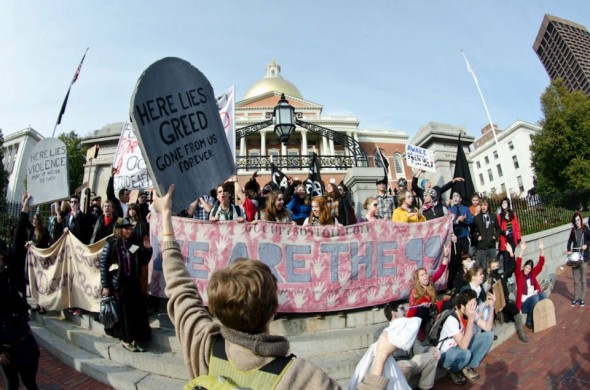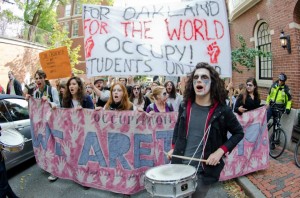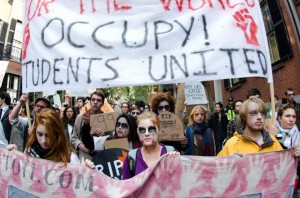Occupy Education: Trick or treat?
 By Matt Bruenig, a student at Boston University.
By Matt Bruenig, a student at Boston University.
The Occupy Movement has exploded in Boston, and area students are out in front. Students in the nation’s largest college city quickly put together an apparatus of organizers from 23 local colleges and universities to work alongside the 99% in its fight against skyrocketing inequality and financial malfeasance.
In an initial show of strength, Occupy Boston Students brought out 3,000 students for a march on Columbus Day, which included local labor allies and Mass. Jobs with Justice.
 A smaller number of students struck out again on Halloween to have their voices heard. Dressed as zombie bankers, around 100 students marched through the streets of Boston to “trick or treat” at the mansions of their overpaid university presidents.The marchers quickly arrived at the $4.5 million dollar mansion newly purchased by Emerson College for its president, Lee Pelton. Emerson students panned the backwards budget priorities of the Emerson administration, the corporatization of the institution, and the rising prices that exclude all but the most privileged.
A smaller number of students struck out again on Halloween to have their voices heard. Dressed as zombie bankers, around 100 students marched through the streets of Boston to “trick or treat” at the mansions of their overpaid university presidents.The marchers quickly arrived at the $4.5 million dollar mansion newly purchased by Emerson College for its president, Lee Pelton. Emerson students panned the backwards budget priorities of the Emerson administration, the corporatization of the institution, and the rising prices that exclude all but the most privileged.
The marchers moved down the street to the mansion of Northeastern President Joseph Aoun. Northeastern students decried the massive salaries paid out to their university administrators, including the $900,000+ salary commanded by Aoun. These salaries, the students pointed out, are made even more insulting by the indefinite faculty pay freezes, and the unconscionably low wages paid out to university staff.
As the march continued on, the message of the students was loud and clear: end the corporatization of higher education, end spiraling tuition, and end spiraling student debt. The marchers chanted “education is a right, not just for the rich and white” throughout the protest, highlighting the ways in which the current higher education system entrenches class and race power structures that it should be trying to demolish.
The Halloween march capped off at the Federal Reserve building adjacent to the Occupy Boston encampment. The students collapsed at both entrances of the building, pretending to die. The mock zombie deaths of a hundred students so terrified the Federal Reserve that the entire building was put on lockdown for a short period of time.
 This march along with hundreds of others across the country are bringing to the surface the unjust nature of higher education in the United States. Although students are much better off than the millions of unemployed and impoverished people who most prominently make up the 99%, rising tuition and debt burdens threaten to smother access to higher education if it has not already.
This march along with hundreds of others across the country are bringing to the surface the unjust nature of higher education in the United States. Although students are much better off than the millions of unemployed and impoverished people who most prominently make up the 99%, rising tuition and debt burdens threaten to smother access to higher education if it has not already.
Reforming higher education must be a necessary element of any widespread social reform to push back against the country’s contemporary tilt towards oligarchy and corporate control. If the higher education system remains a system for renewing the privilege of the rich and white while simultaneously indebting everyone else, the Occupy Movement will be critically undermined. Absent such reforms, generational transfers of power, privilege and wealth — which the higher education systems crucially assists in — will continue, and the massive inequality and economic injustice that the occupiers have highlighted will inevitably persist.
